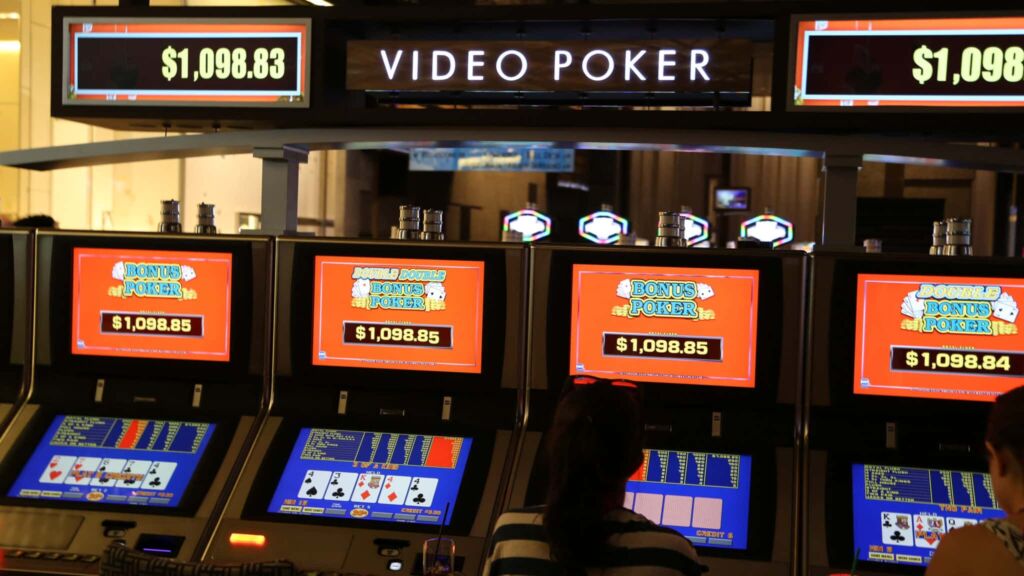Video poker combines an engaging mixture of chance and strategy, progressing from early gambling machines with simple mechanics to the advanced algorithmic designs in online gaming platforms. This comprehensive discussion covers the historical trajectory of video poker, highlighting its growth, significant advancements, and its lasting allure to a wide range of enthusiasts.
Origins of the Mechanical Age: An Introduction to Electronic Predecessors
Before digital displays became commonplace, video poker's roots trace back to the late 19th century through purely mechanical innovations. The Brooklyn-based company Sittman and Pitt constructed a device in 1891 that, although not traditional video poker, encapsulated its basic essence. The machine had five rotating barrels adorned with 50 cards, excluding the Jack of hearts and ten of spades to slightly diminish the chances of a royal flush. Patrons would insert a coin and pull a lever, resulting in a poker hand depicted on the barrels.
These early poker devices, installed in numerous New York bars, introduced a novel form of self-operating gambling. The absence of automated payouts led to winning hands being exchanged for prizes like complimentary beverages, cigars, or meals at the bar. The communal activity of claiming rewards from the bartender added a social layer to the otherwise solitary gaming experience. Additional variations using poker dice surfaced, underlining the growing fascination with automated poker-like games. Despite their limited complexity and missing key features like the draw function found in today’s video poker, these mechanical forerunners laid the groundwork for the public's growing interest in machine-driven poker and paved the way for future electronic advancements.
The Electronic Era Emerges: Fortune Coin and the 1970s Video Poker Transformation
The 1970s represented a turning point when electronic advancements began reshaping casino gaming landscapes. During this decade, the genesis of authentic video poker occurred, intertwining television technology with poker's established charm as a gambling form. In 1970, Dale Electronics introduced 'Poker-Matic,' often acknowledged as the inaugural electronic poker iteration. Despite its retained mechanical elements, 'Poker-Matic' deployed electronic circuits to oversee gameplay and payments, marking a crucial stride toward entirely digital video poker.
By 1975, Fortune Coin Co., spearheaded by Walt Fraley, achieved a monumental advancement by marrying a modified 19-inch Sony Trinitron color television with advanced circuitry to produce a fully electronic video draw poker game. This breakthrough, swapping mechanical reels for a video display of cards, enhanced game design flexibility and visual attraction. Initially featured at the Las Vegas Hilton, this device, soon coined “Video Poker,” immediately gained player popularity. Its appeal was attributed to several factors: the familiar poker rankings, captivating video display, and quicker gaming pace compared to mechanical slots.
Si Redd, representing Bally Technologies at the time, recognized the vast potential in Fortune Coin's creation. He successfully negotiated the distribution and eventual acquisition of Fortune Coin, integrating video poker into a reputed gaming manufacturer’s portfolio. By 1979, under International Game Technology (IGT), then led by Redd after acquiring Fortune Coin, “Draw Poker” debuted as a refined and commercially viable version of the original machine. Crucially, the Nevada Gaming Commission granted regulatory permission for video poker, officially recognizing it as a legitimate casino game, clearing the path for its extensive adoption throughout Nevada and further afield. The late 1970s not only marked the technological birth of video poker but also its seamless integration within the established casino sector, setting the foundation for its rapid growth in the 1980s.
1980s: Advances, Game Variations, and In-Depth Strategies
The 1980s proved to be a defining era for video poker, catalyzing its shift from a niche attraction to a dominant casino staple. This period saw brisk technological advancements, iconic game versions emerging, and evolving player strategies.
IGT, under Si Redd's guidance, came to the forefront of the expanding video poker scene. Their launch of “Jacks or Better” in the early 1980s was a strategic triumph. This version, known for rewarding hands featuring a pair of Jacks or better, became the fundamental model of video poker. The payout structure for “Jacks or Better,” particularly the 'full pay' 9/6 iteration (9 coins for a full house, 6 for a flush), ensured a high return to player (RTP) rate of about 99.5% with optimal technique. This openness and favorable RTP, compared to traditional slot offerings, drew in a more strategic and astute audience. The idea of ‘full pay’ games set a pivotal distinction for video poker, focusing on skills and informed gameplay.
During the 1980s, additional lasting video poker versions took root. “Deuces Wild,” leveraging the wild card idea, assigned wild status to twos, altering hand probabilities and optimal player strategies. This variation promised the potential for high-reward hands and a more dynamic playing experience. “Joker’s Wild,” which included a single wild Joker card, introduced further complexity and strategic thinking. These diverse gaming choices broadened video poker's attractiveness, catering to varying risk levels and strategic preferences. Companies like Bally Technologies and Universal Distributing of Nevada participated actively in the market, stimulating game development and competitive dynamics.
Technological improvements throughout the 1980s consistently upgraded the video poker format. Color screens became common, enhancing visual appeal. Microprocessors grew more sophisticated and cost-effective, allowing for more intricate game mechanics, enhanced graphics, and better machine reliability. The transition to solid-state electronics lowered mechanical breakdowns and maintenance expenses, making video poker machines more profitable for casinos and more reliable for players. By the decade's close, video poker had cemented itself as an integral part of the casino gaming environment, amassing a dedicated following and generating significant profit.
The Golden Age: Internet Expansion and Diversified Games in the 1990s
The 1990s heralded a 'golden era' for video poker, marked by its extensive penetration into both traditional brick-and-mortar casinos and the burgeoning sphere of online gambling. This era saw video poker achieve unparalleled popularity and accessibility.
Casinos worldwide began dedicating more and more floor space to video poker machines. The variety of game types expanded, and the introduction of multi-hand video poker machines became a hit. These machines allowed players to engage in multiple hands concurrently, typically up to three, five, or even ten hands simultaneously, thus considerably increasing the gaming pace and probability for winnings or losses. Multi-hand configurations appealed to those desiring faster excitement and greater volatility, further enriching the video poker experience.
The internet revolution of the 1990s marked a pivotal shift for video poker. As digital casinos began coming online in the mid-1990s, video poker was one of the first casino games to make the digital leap. Recognizing their appeal, early online platforms offered digital versions of favorite games like “Jacks or Better” and “Deuces Wild.” Online video poker presented unmatched convenience, enabling players to gamble from their own homes, any time of day or night. This accessibility significantly broadened the player audience, reaching those far from physical casinos or those who appreciated the privacy of online gaming.
The emergence of online video poker owes much to the innovative efforts of software developers. Major companies, namely Microgaming and Cryptologic , were at the forefront of this transformation, bringing to life video poker platforms that were both intricate and intuitive for users. The visual and auditory aspects were significantly enhanced, creating an experience that closely resembled that of a physical casino. Online venues often offered better payout structures and enticing bonuses to lure in players, making the virtual space highly competitive.
This digital shift also encouraged the development of comprehensive resources for video poker strategy. A plethora of websites emerged, offering in-depth analysis of strategies, extensive pay table databases, and tools for calculating optimal plays. As a result, players were more equipped to hone their skills and approach the game with informed strategies. In the realm of online video poker, games featuring progressive jackpots gained widespread popularity, offering the thrilling prospect of winning substantial sums with participants from around the globe. The 1990s truly marked the era where video poker solidified its prominence both in physical casinos and the rapidly growing online gambling arena.
Video Poker in the Digital Age: Emphasis on Mobility, Skills, and Future Trends (From the 2000s to Today)
Entering the 21st century , video poker underwent significant changes, adapting swiftly to technology's fast pace and diverse user preferences. This period is marked by the explosion of mobile gaming, a focus on skill-oriented play, and initial steps toward integrating cutting-edge technologies such as Virtual Reality and Augmented Reality.
The leap into mobile gaming has left an indelible mark on video poker. With the universal spread of smartphones and tablets, video poker apps and mobile-compatible sites have made it easy for users to access the games at any time and place. This accessibility has democratized the game, making it possible for people to enjoy a quick round during commutes or breaks. Particularly, younger audiences who are comfortable with mobile platforms find themselves drawn to this form of entertainment.
In the 21st century , there's been a renewed focus on the elements of skill and strategy in video poker. The internet now offers numerous resources to help players learn the best strategies. There are websites, strategic charts, simulators, and training programs that allow gamers to experiment with pay tables, explore refined tactical decisions, and navigate the different types of video poker games. Machines known for offering the best odds, like 9/6 Jacks or Better and 10/7 Deuces Wild , remain attractive to avid players eager to maximize their chances. The concept of “advantage play,” which involves using favorable pay tables or casino promotions to gain statistical benefits, has captivated a dedicated niche audience.
Video poker continuously evolves, with a wide range of exciting new formats being introduced beyond the typical versions. These include games with bonus features, multipliers, etc., delivering novel and electrifying gaming experiences. Some games, such as “Bonus Poker,” “Double Bonus Poker,” “Double Double Bonus Poker,” and “Triple Play Poker” , offer higher payouts for specific hands, thereby increasing the game's volatility and jackpot potential. There has also been a melding of video poker mechanics with other casino games, including slot machines, effectively blurring traditional game categories.
Looking forward, video poker is on the cusp of even more thrilling innovations. The advent of VR and AR technologies presents possibilities for creating deeply immersive video poker scenes that simulate a real casino's ambiance. Integrating social elements like multiplayer tournaments and leaderboards could enhance player interaction and community building. As global online gambling regulations continue to evolve, they will inevitably affect video poker's accessibility and reach worldwide. In a constantly shifting landscape of online gambling, video poker's unique combination of skill, strategy, and availability ensures its lasting influence and appeal within the gambling community.
The Psychological and Social Appeal: What Keeps Video Poker Thriving
Video poker remains a favorite not just because of the gameplay but due to its psychological and communal appeal. It stands in a unique position among gambling activities, bridging the solitary experience of slot machines with the interactive environment of table games.
Psychologically, video poker provides a sense of control that is often absent in games purely based on luck. Players engage with strategic decision-making, deciding which cards to hold or discard, which creates an illusion of autonomy despite the statically defined odds. This aspect makes the game particularly engaging, offering more than just mindless button-pushing and instead requiring intellectual involvement. The game’s quick pace and immediate outcomes add to its addictive nature by constantly engaging the player. The 'near miss' phenomenon, where high-value hands like royal flushes are just barely missed, intensifies the drive to keep playing in pursuit of a big win. However, it's crucial for players to stay aware of the house edge and practice responsible gambling to minimize potential negative impacts.
Although often played alone, video poker can also foster a sense of camaraderie, especially within physical casinos. Groups of video poker machines become informal meeting places where players exchange tips, celebrate successes, and share experiences. Online platforms push this even further, offering chat functions and hosting multiplayer events, creating virtual communities of video poker enthusiasts. Even though it doesn’t have the same level of social interaction as in-person poker games, video poker still provides opportunities for shared experiences and interactions, further broadening its appeal.
Summary: A Trail of Innovation and Lasting Popularity
The story of video poker’s progress is a narrative filled with creative developments and adaptability. From its rudimentary mechanical beginnings to its sophisticated present digital form, video poker has evolved along with technological advancements and player tastes. What makes it so enduring is its blend of poker strategy, ease of access similar to slot machines, and rewarding payouts (especially for skilled players utilizing select game variations). For many gamblers, video poker offers an intriguing mixture of skill and chance, and a potentially lucrative gaming experience.
As technology continues to develop, exciting innovations in video poker are anticipated, including VR and AR experiences, enhanced mobile versions, and a mix of new game types that will carve out future chapters in its story. Understanding its historical significance enriches one's appreciation of this strategically engaging and consistently popular game. Video poker maintains its standing as a vibrant form of gambling entertainment, whether enjoyed in a bustling casino or via an online connection, offering a unique and captivating experience for players around the globe.
External Resources:



